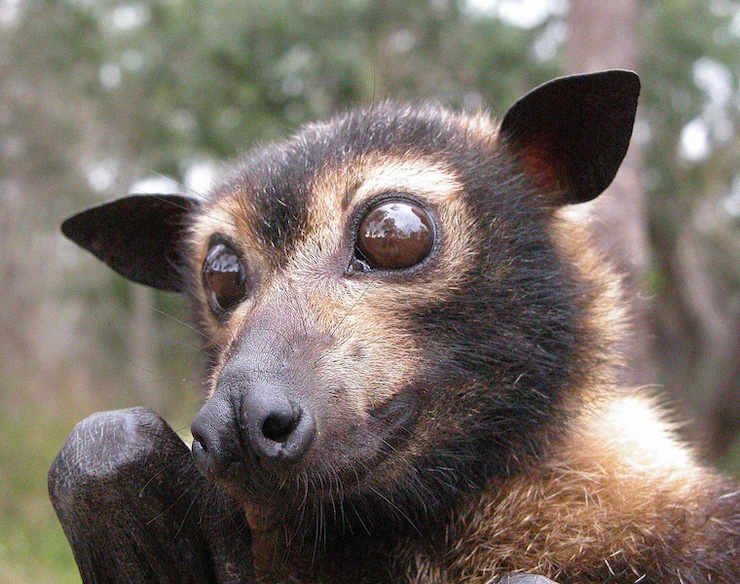
© CSIRO
James Cook University (JCU) in Northern Queensland, Australia, is particularly known for its environmental studies programs. The school’s proximity to the UNESCO World Heritage-protected Wet Tropics of Queensland provides a wide range of research opportunities. As Australia’s leading tropical research university, JCU is home to the Centre for Tropical Environmental and Sustainability Science (TESS). TESS’s website states, “Our mission is to promote cutting-edge ecological and environmental research in the tropics, and the wise management, conservation, and sustainable use of tropical terrestrial and coastal ecosystems, in Australia and internationally.”
Upholding this mission is Ph.D. student Emmeline Norris, whose research focuses on how technology like drones can be used to better understand the spectacled flying tree fox, an endangered megabat. Since the species calls dense rainforests its home, getting close to the bats in their natural habitat can be challenging. This is why researchers like Emmeline have begun using non-invasive drones with thermal imaging capabilities to gather data on rainforest species. On November 21 and 22, 2024, Emmeline headed out to the Daintree Rainforest Observatory (DRO) in the lowlands of Cape Tribulation, Queensland, to begin a drone survey of the spectacled flying tree fox.
Minutes into launching her drone, Emmeline abandoned her search for the spectacled flying tree fox when she spotted a much more elusive creature hidden amongst the tree canopy—the Bennett’s tree kangaroo. Because Bennett’s tree kangaroos live in the rainforest canopy, very little is known about them. Emmeline even refers to them as a near-mythical creature. Emmeline’s drones, a DJI Matrice 350 RTK and DJI Mavic Enterprise 3T, revealed the heat signature of a creature much larger than a spectacled flying tree fox. Upon closer examination through the drone’s color zoom camera, she was able to confirm that the creature was, in fact, a Bennett’s tree kangaroo.
Emmeline’s findings were published in the February 4, 2025, issue of Australian Mammalogy. In the paper, she explains that over the course of three drone flights, she spotted a total of six individual Bennett’s tree kangaroos. She was even able to identify the unique plant species the animals were eating, shedding more light on the elusive creatures. She goes on to explain how she was able to successfully implement drone technology where others have been reluctant to use it in rainforest settings.
“I think a lot of people have been put off from using thermal drones in tropical forest environments because they hear that they don’t work so well in the warm conditions, or because the vegetation is quite dense,” she said. She went on to give an example of how, when she flew the drone later in the day, she got false positive results. The thermal camera picked up the heat signature of a green ant nest that heats up in the afternoon sun, resembling the body mass of a mammal.
However, she said this is something that can be rectified by flying drones at key times of the day and season. “This is still the very early stages of this research, and we’re hoping to get some more opportunities to fly in different areas throughout the Daintree National Park so that we can learn more,” she continued.
One of the unique aspects of the DRO is the 47-meter observation crane that rises above the tree canopy. By climbing to this vantage point, Emmeline was able to operate her drone, keeping it within visual line of sight at all times, in accordance with Australia’s Civil Aviation Safety Authority’s (CASA) regulations. She notes that while similar structures may not be available at other research sites, a drone could still be used if the operator is on a vantage point such as a hill or bridge. Regardless, such information gathered by drones is invaluable.
Emmeline points out in her paper that Bennett’s tree kangaroos are listed as a near-threatened species, partially because they are too elusive to formally observe for adequate population counts. She goes on to say that the drone data provides evidence “that Bennett’s tree kangaroos are abundant in lowland rainforest at Cape Tribulation, supporting the idea of their population expansion.”
Emmeline’s groundbreaking work with drone technology not only opens new doors for studying elusive species but it also highlights the potential of non-invasive methods in ecological research. By combining innovation with a deep understanding of the rainforest environment, her findings contribute to the ongoing efforts to conserve and better understand Australia’s unique wildlife.
|